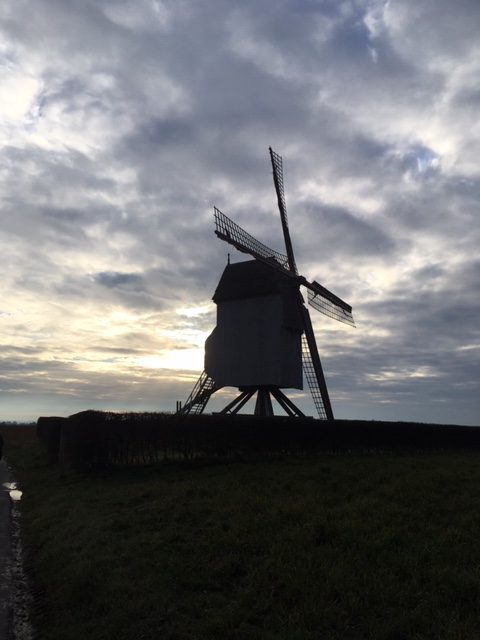In the spring, an old man’s fancy lightly turns to thoughts of Belgium.
(Lord Tennyson omitted this line from his poem, but only because nothing rhymes with Belgium.)
The Ronde van Vlaanderen is held on the first Sunday in April, and the rest of the early spring races key off this event’s date. Gent-Wevelgem, Dwars door Vlaanderen, Flanders Sportive, and the Ronde all come together for a mad celebration of cobbles, mud, rain, wind, and beer. For my son and me, Flanders Week 2018 coincided with Spring Break. I made an executive decision and bought tickets, justifying the trip as a cultural experience that coincided with my son’s 11th birthday.
It would be a learning opportunity, clearly. Not only would my son see new places, ride famous cobbles, and witness firsthand the madness of riding with 16,000 other people, he would get to watch me drink really good beer.
When I suggested this plan, my lovely and tolerant wife rolled her eyes, which I interpreted as tacit approval. She knew that it meant a week of peace and quiet at home for her. Next, I called my good friend Uncle Crusty, and suggested that he come along. Crusty and I have been good friends since early childhood, have ridden bikes together for years, and have repeatedly gone on misadventures and gotten in and out of trouble.
“My wife will not sign off on that,” he said. “No way will she let me go to Belgium and ride my bike.”
“I figured you’d say that. What if I bought you a non-refundable plane ticket? Then you have no choice.”
“Well, that might work.”
“How about you buy the beer and food and we’re even?”
“A guy’s gotta eat,” Crusty said. “And drink.”
With that minor logistical issue checked off the list, it was time to do research. I found a hotel in Bruges for a very reasonable price, bought Simon Warren’s Belgium’s Greatest Climbs, and enrolled us in the Flanders Sportive, to be held the day before the Ronde. I pored over convoluted and twisty routes, trying to understand the Flemish Ardennes and the locations of famous climbs like the Koppenberg, Oude Kwaremont, Muur, and moore.
Since we would be staying in Bruges, we would need a car. Being from the American West, I am accustomed to wide roads with few turns, large parking spaces, and ample room for quasi-legal U-turns. The thought of navigating anything larger than a smart car in Belgium, particularly in Bruges, was unsettling. In my studies, though, I found a park-and-ride lot just outside the city wall, a bit under a kilometer from the hotel. Presto! We could stash the car in that lot and ride our bikes back-and-forth from the hotel. I also found a good deal on a minivan, which would carry the three of us and our bikes.
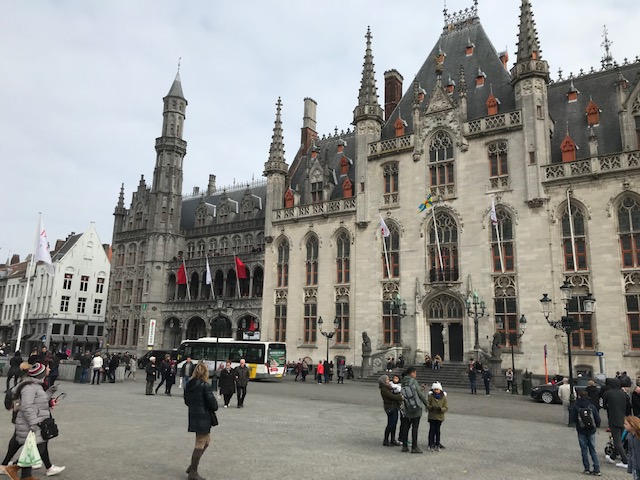
Brussels is an easy airport to reach, with connections from Boston, JFK, Newark, Chicago, Houston, and Atlanta. Despite driving to Denver in an absolutely epic snowstorm, which turned a 2-hour drive into a 5-hour slog, our travel was easy and uneventful. We picked up our minivan, a brand-new vehicle with a whopping 6km on the odometer. It had a truly impressive sat-nav in the dashboard and a very proper female voice with an English accent. We named it Agnes. For the next 7 days, Agnes was our guide and companion, and she kept us from ever getting lost.
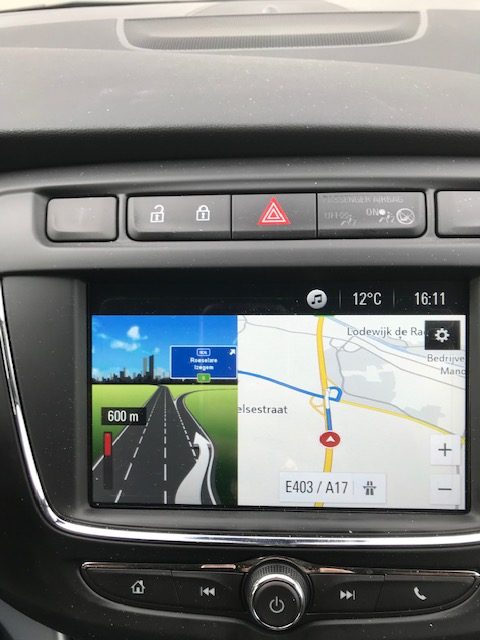
We drove west to Bruges, found the park-and-ride, and started the short 800m walk to the hotel. Although 800m is by no means a long distance, when you’re jet-lagged and schlepping bikes and suitcases, it’s far enough to feel like you’ve traversed a continent. Along the way, we trudged along narrow sidewalks and cobbled streets, our excitement growing about testing our skills on the famous stones of Belgium. A woman rode past us, clearly on her daily commute. She wore a black dress, heels, and long woolen coat, held a cigarette to her lips in one hand and her phone to her ear with the other, and she floated down the cobbles hands-free.
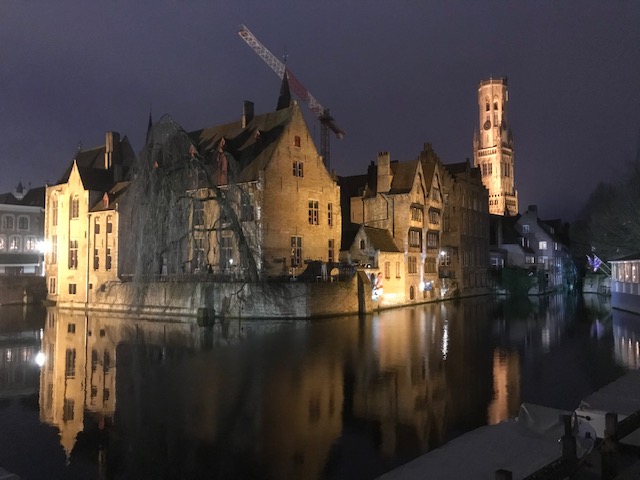
It was immediately obvious that whatever riding skills we collectively had were no comparison to the locals. We had work to do.
We had the bikes unpacked and assembled quickly, then set out on foot to explore Bruges and hopefully find a place to watch Gent-Wevelgem on TV, which was due to start in an hour or two. Bruges is a beautiful city, with fantastic architecture and tourist traps. It’s very walkable, and we certainly walked it, taking photos and enjoying the experience. Eventually we found a bar with 8 TVs, all tuned to the race, just as we had hoped for.
Strangely, it was empty. In a country known for being cycling-mad, it seemed odd to find a completely empty bar with the bike race visible no matter how you turned your head. Perhaps everyone was roadside, cheering in person, rather than indoors. Nonetheless, we persisted, watched the race, ate snacks, and drank beer. This was what we were looking for, and it was good.
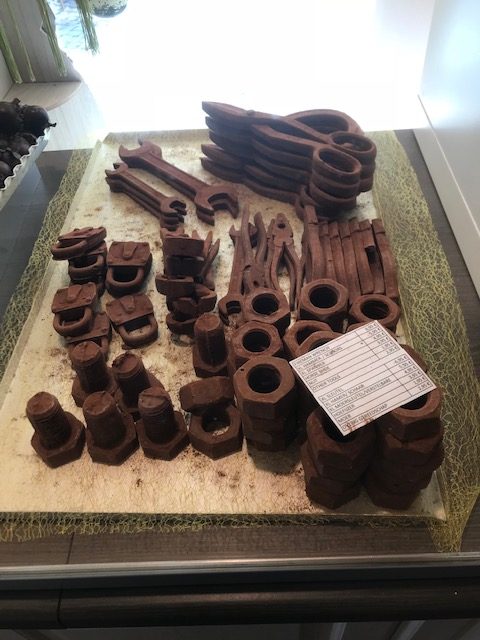
The next morning we dressed and headed back to our park-and-ride to re-join Agnes and have her lead us to Oudenaarde, ground zero of the Flemish Ardennes. The current finish city of the Ronde, Oudenaarde is surrounded by narrow cobbled roads and steep hellingen. It has a pretty city square, with the famous museum at the south end. Just past the museum is a small paid parking lot adjacent to the police station- as tempting as this lot is, if you proceed out of town another few hundred meters, there are larger, free parking lots. I recommend these, now that I know the cost of a parking ticket in Oudenaarde.
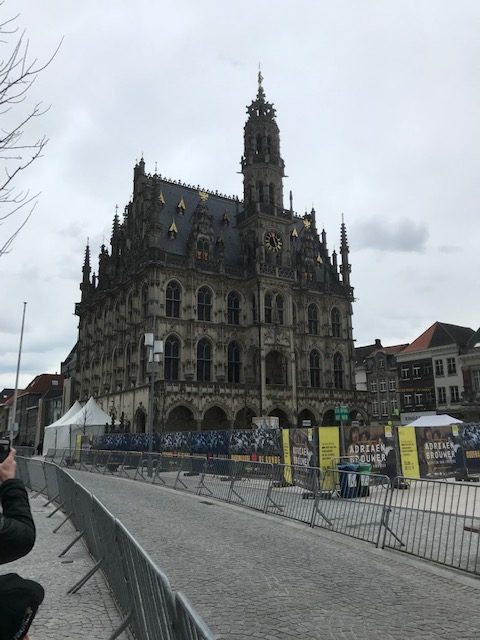
We followed a .gpx route I had downloaded that took us in a generally clockwise loop south- and eastward of the city, and we checked off cobbled climb after cobbled climb. Naturally, we were excited to ride the Koppenberg on an empty day, as we made the climb without a dab (unlike the day of the sportive).
Our loop brought us into Ronse, on the southern side of the Flemish Ardennes. It was around 2pm, on a Monday, and we were about halfway around our route for the day. Ronse is a sizeable town, and has a large city square lined with restaurants and stores. We parked our bikes and went into the first restaurant we saw, and sat at a table.
One would assume that during Flanders Week, when the cycling world is focused on one small area just west of center in a small country known for rabid cycling fans, that one could enter a town along a famous race route, wearing garishly colored lycra, that one would be able to get lunch in a business that sells food.
Wrong.
We got some pretty strange looks from other patrons as we looked at the menu and asked if we could order. Eventually, someone suggested a pizza place on the other side of the square, which was closed. Evidently, Ronse is not a culinary center. If you travel to the area, I recommend bringing a sandwich.
Hunger unsated by a few stale Clif Bars I had brought along, we headed out, up and over the Oude Kruisberg and off towards the Oude Kwaremont and Paterberg.
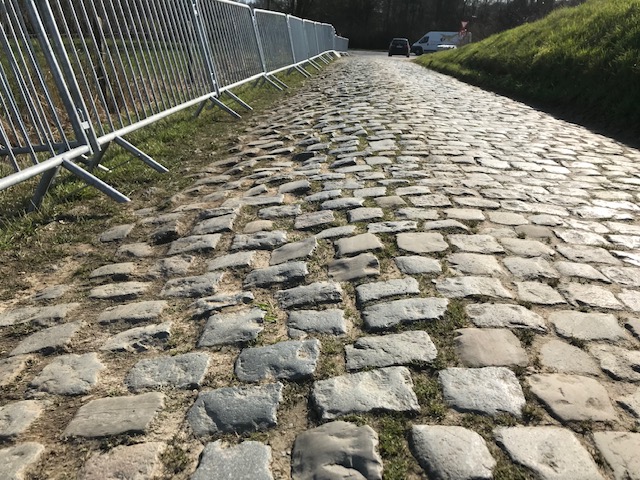
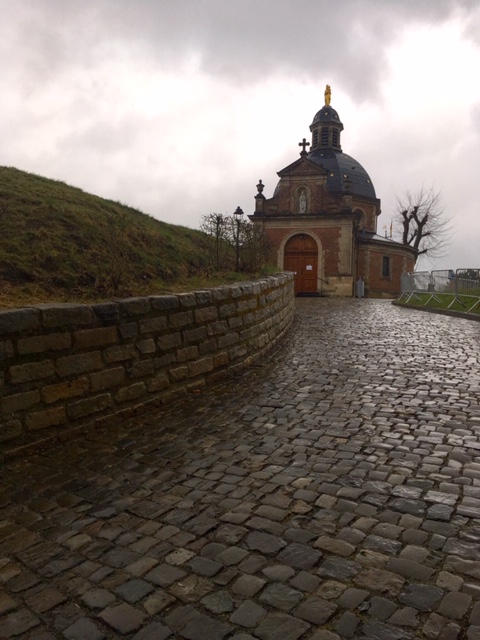
Much has been written about climbs such as the Taaienberg, Hotondberg, Knockteberg, Eikenberg, Kanarieberg, Leberg, Molenberg, Valkenberg, Tenbosse, Muur-Kapelmuur, and Bosberg, and you are welcome to go read it all. I won’t recap it here, mainly because my fingers are still vibrating from the cobbles. Suffice to say that they are all great fun to ride if you are not racing. We enjoyed them all, playing in the hallowed halls of the stone kings.
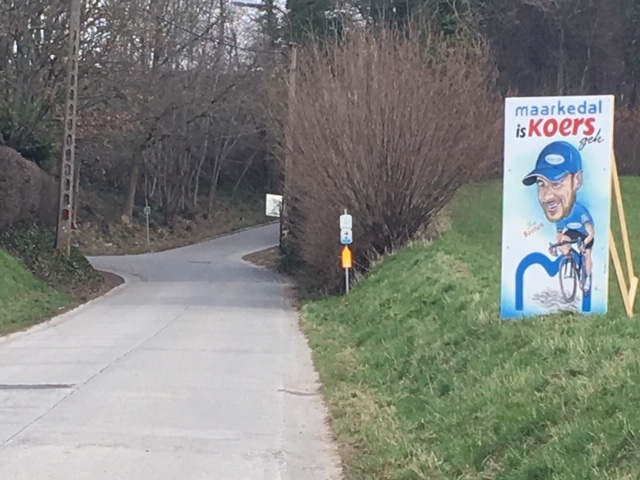
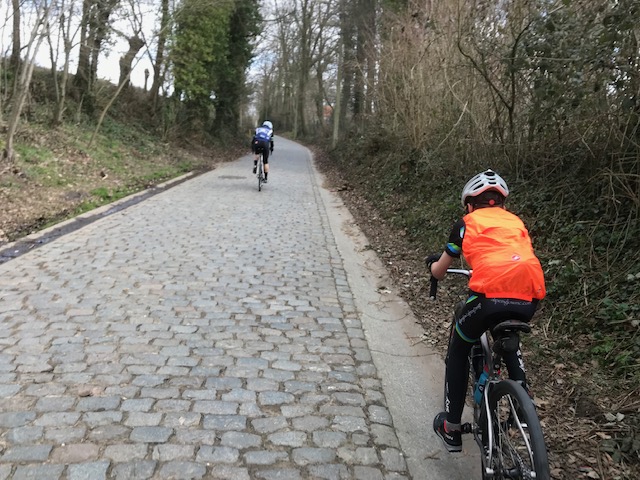
Also written elsewhere are many descriptions of how to ride cobbles, with a firm but loose grip on the bars, big rings, and so forth, but I also strongly recommend 650b x 42 tires at 40PSI. These cushy balloons made the cobbles fun and enjoyable, and I kept all my fillings. I could not imagine riding on 28c tires at 120PSI; I expect it would drive your prostate up between your tonsils, which sort of takes the fun out of a cycling vacation.
We returned to Oudenaarde, moved Agnes to the free parking lot, then went to the square for frites and some refreshing beers. We also explored the museum, complete with a Volvo on Molteni livery parked outside. It was, truly, a bike-nerd version of nirvana (the enlightenment type, not the grunge). The museum also has a nice cafe for pre- or post-ride snacks. We hoped to meet Freddy Maertens, who is often at the museum, but he wasn’t there.
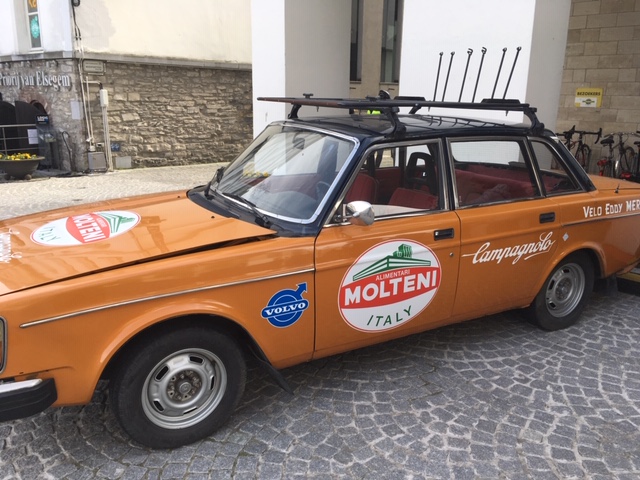
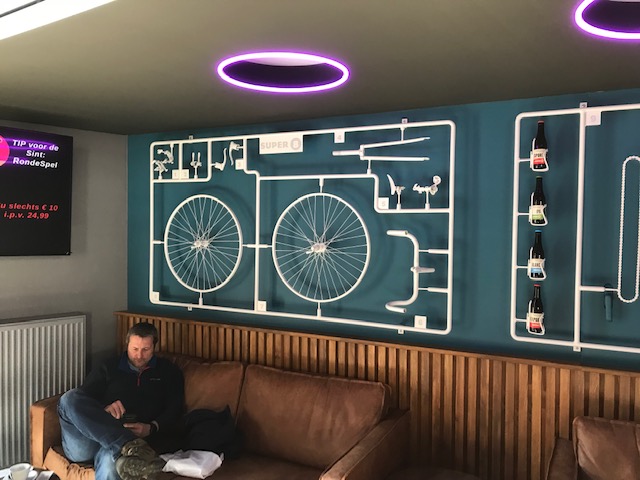
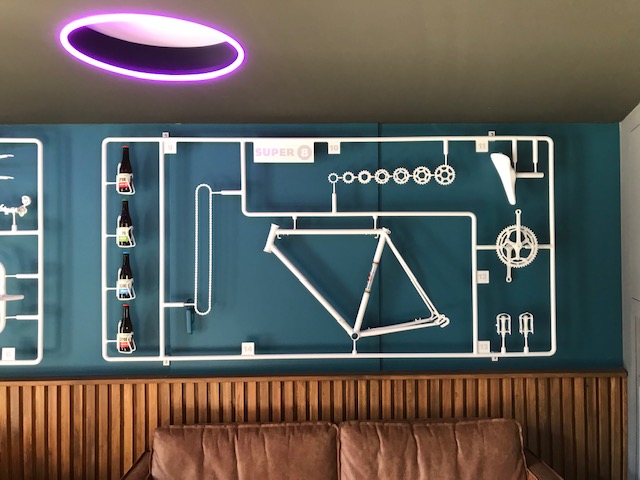
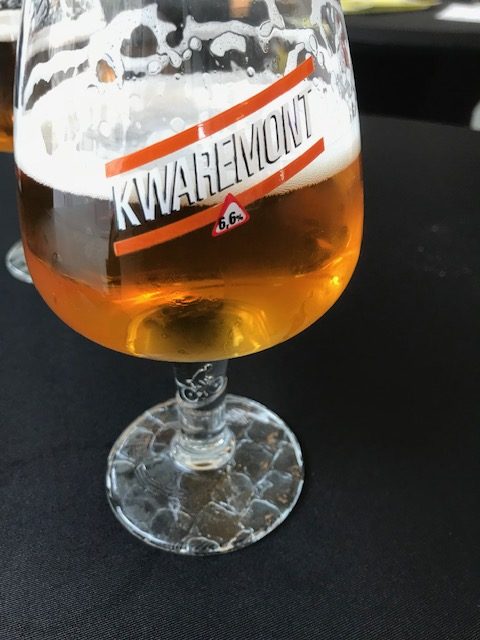
The next day we again asked Agnes’ guidance as we headed southwest towards the French border. Gnarly cobbled sections awaited, and the drive across the pan-flat northern French countryside went quickly. Parking outside Haveluy, we kitted up, keeping a way eye on the building clouds and gusts of wind. The Haveluy sector was under construction, so we skipped it, but not before chatting with Les Amis du Paris Roubaix, who were re-setting cobblestones.
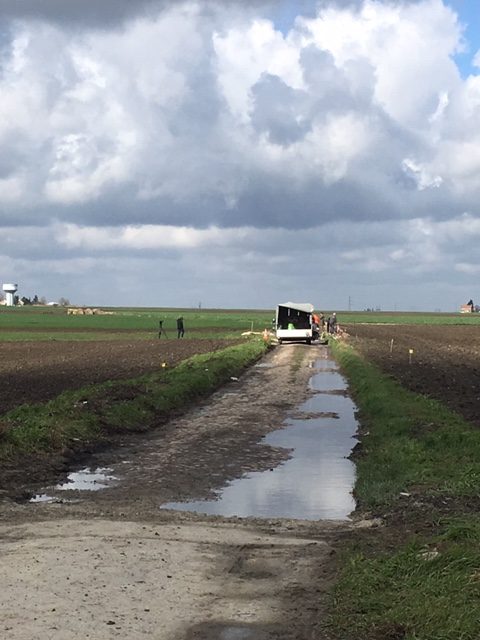
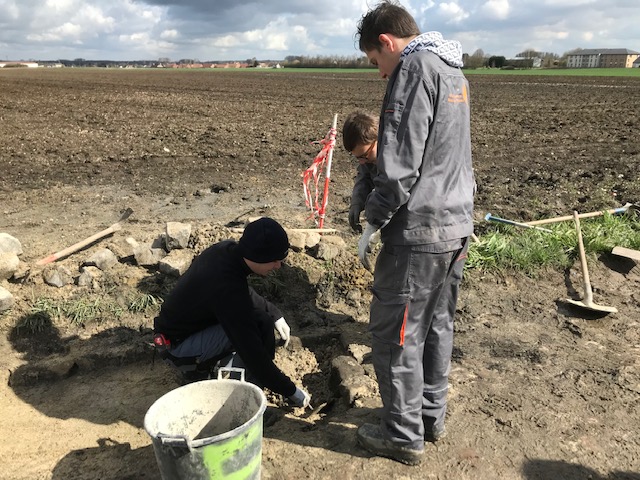
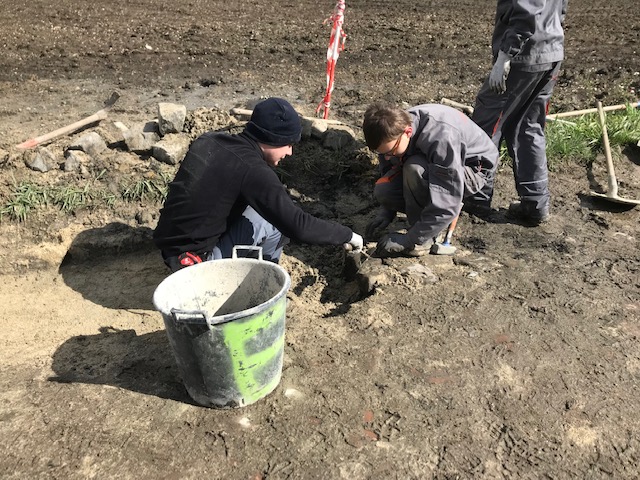
Looping around the town and heading northward, mounds of mine tailings and towers marked the approach to the Trouee d’Arenberg. I’ve been on World Cup and Olympic downhill pitches, carrying materials and equipment on slopes as steep as 45 degrees, with the snow turned into ice, so I have a bit of familiarity with famously challenging sports arenas. The nervousness I felt on the pitch at the Hahnenkamm fluttered back into my chest as we swept past the gate and saw the cobbles.
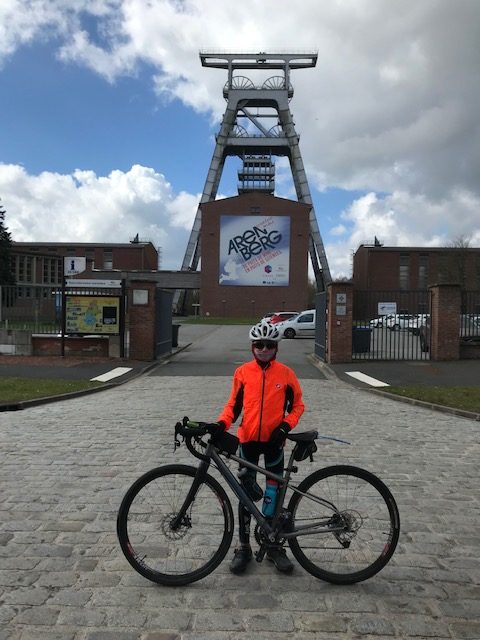
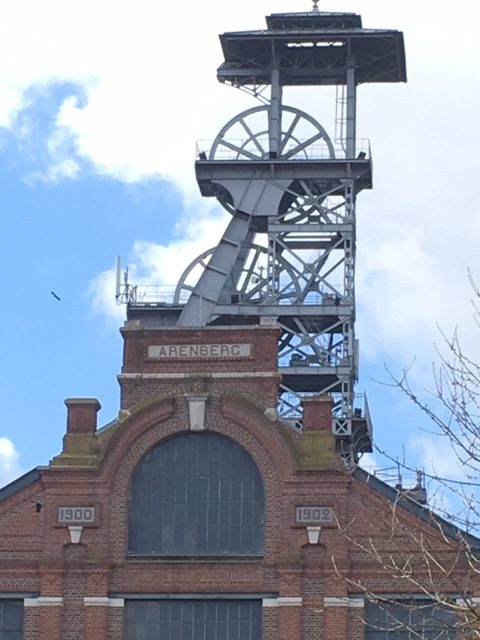
The Arenberg has delivered untold numbers of injuries to cyclists, has seen pitched battles to be the first into the forest, and thousands of rowdy fans screaming at the tops of their lungs. Today, it was silent and empty, save the three of us and one guy with a propane torch burning moss from between the stones.
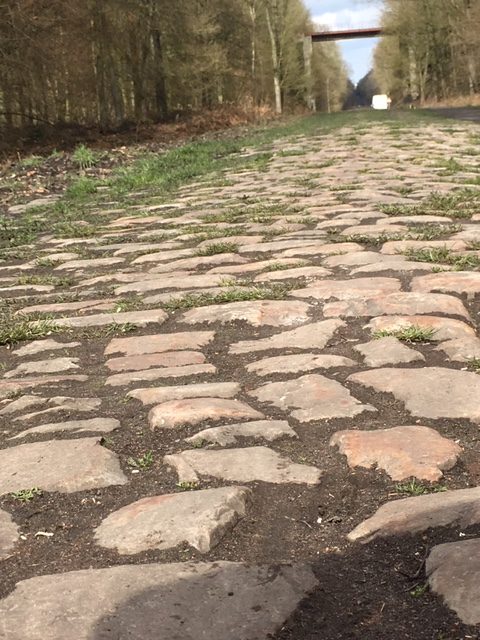
My 650b tires worked their magic, and the bike felt great. In fact, despite my initial trepidation, this was fun and exciting. As with the Flandrian cobbles, I was very happy to be touristing, not racing. We played a bit, filming each other, riding on and off of the cobbles, taking pictures. Eventually, we used up the 2km of the Trench, and we rolled back onto pavement and towards the next sector.
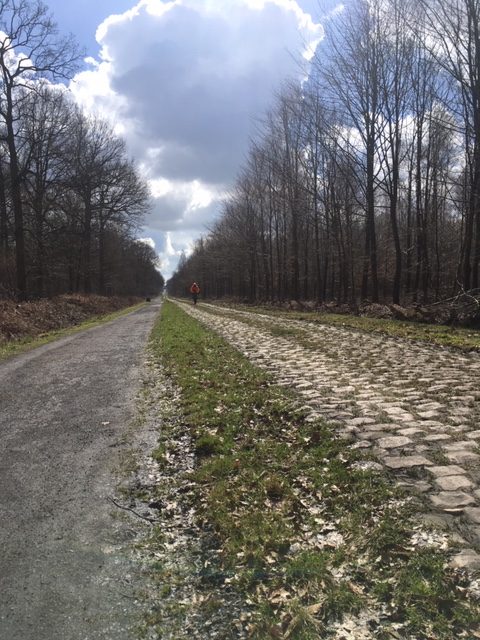
It was interesting, as we tested our mettle on 4 or 5 different sectors, how the star-rating for each seemed arbitrary. Honestly, I could not discern a significant difference between 3- and 5-star cobbles, as each section provided new challenges and vibration frequencies. By the time my son declared, “my insides have shaken loose”, signaling a time to return to the car, I had decided the ratings were like blue squares and black diamonds at ski areas- graphically interesting but no bearing on reality.
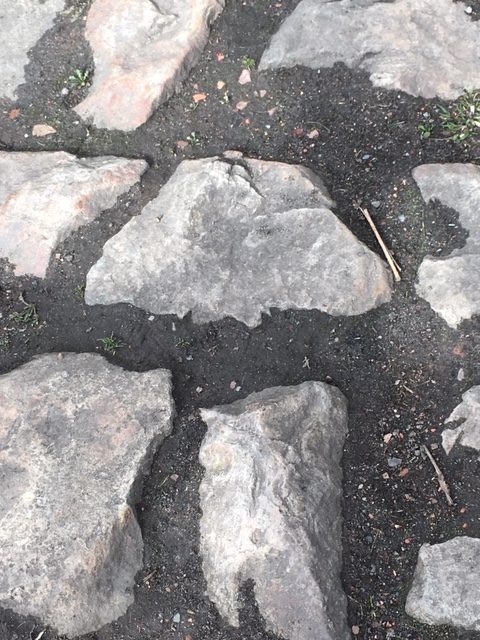
There’s no question that an avid cyclist needs to experience the Roubaix cobbles, and it’s really quite fun. That said, I really have no interest in the Roubaix Sportive, as 4 or 5 sectors was plenty to try out. We returned to Bruges, where another satisfying dinner of Flemish Stew (worth the trip alone), frites, and beers capped an exciting day. It must be said that dining in Bruges is a true pleasure, every place we visited was delicious and reasonably priced.
Perfect Belgian weather greeted us the next day: cold wind, occasional showers, and low clouds chased us as we headed east in Agnes. As always, her guidance was perfect, and before long, we were parked on the banks of the Muese river, south of Huy. 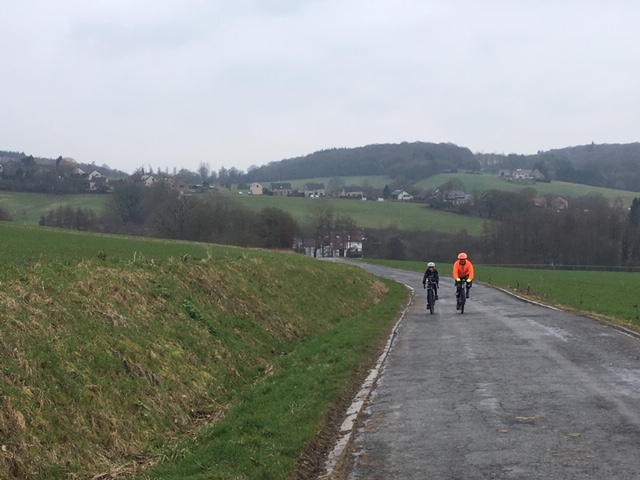
The riding in Wallonia is different than Flanders, with fewer dedicated (and painted, cobbled, curbed) bike lanes but similarly quiet roads once outside of the center of town. Our goal was the Mur de Huy, and along the way, an exploration of the surrounding countryside. Rain showers moved through as we rode, alternating with a cool wind. The countryside reminded me somewhat of riding in Marin County, but with considerably fewer BMWs.

We worked our way to the center of Huy, then followed the signage to the Chemin des Chappelles, the real name of the road to the famous climb. It ramps up quickly as you start, then gets very steep at the famous S-bend. The grade continues to an amusement park at the top of the hill, where we took quick pictures as the rain picked up. Close to the bottom of the hill is a wonderful cafe, the Mur. They provided a warm and cozy refuge from the rain, delicious food, great conversation, and a place you could sit all day and enjoy perfect coffee. Visiting the Mur cafe alone is worth the trip.
Our adventure in Belguim was nearing its final act: the We Ride Flanders Sportive. The event sells out all 16,000 entries, so if you’re considering doing it, buy your tickets in December. I’ve ridden lots of fondos and sportives, but none like this. Although it’s crowded, you’re really not riding with 15,999 other people all at once. Plus, they mark and marshall the course extremely well, and you can ride along with the flow and enjoy yourself. During the entire 138km version we did, I did not hear or see a single crash.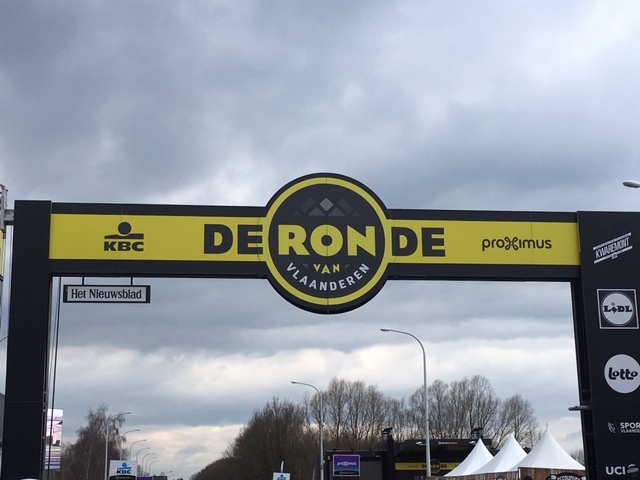
The sportive was also a big goal for my now 11-year-old son: it would be his longest ride to date. He was excited, and the added challenge of a crowded route on top of cobbles and bergs promised a big day on the bike for him. Number plates issued by the organizer also had your name printed, and on some climbs they had DJs and festivals. As you crested, the DJ would scream out your name in encouragement. We also heard some old guys at the bottom of the Oude Kwaremont cheer his name and raise their beers.
It should be pointed out that if you only pick one day to ride the famous climbs cleanly, this is not it. There is simply no way you are getting up the Koppenberg without walking. All the other climbs will similarly force a dismount, either from someone bumping you, stopping in front of you, or stopping way in front of you so that everyone else stops. A couple of British guys complained on the Koppenberg about this, and Crusty pointed out they had 364 other days to try the climb, and that the UK was considerably closer to Oudenaarde than Colorado, and that they didn’t hear him bitching. It may not have been the most conversational comment to make, but their whining ceased.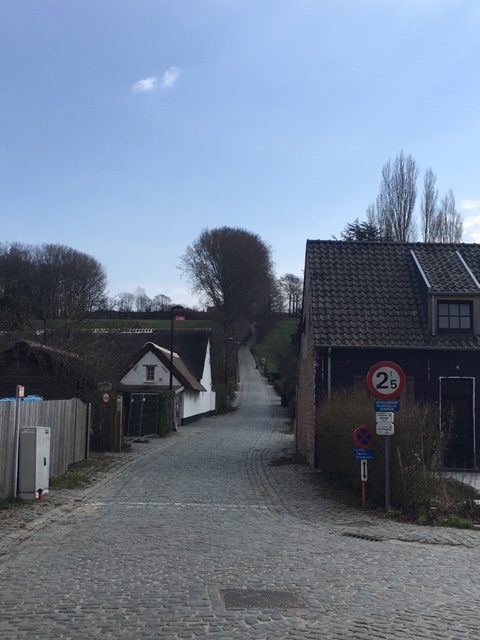
The sportive follows the Ronde route, sort of. It covers all the same climbs, but as the Ronde varies year to year, not necessarily in the same order. It also brings you back to Oudenaarde on the finish, so you get to practice your sprint. My kid ramped up his speed, although I made him promise to shut it down before the actual line, where there was a veritable wall of Mamils. They had all crossed the finish and stopped, centimeters from the line. I had visions of him barreling into the solid Mamilian mass and richocheting like a cueball. Fortunately, he slowed down, and no Mamils were injured.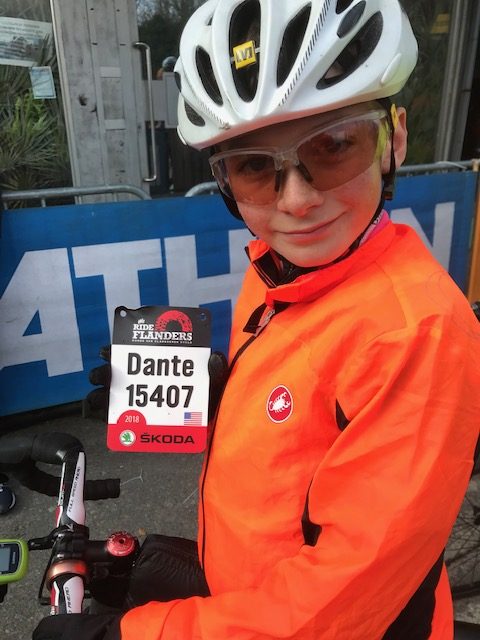
Belgium is well worth a visit, even when no events are in session. Travel from Zaventem Airport into Brussels and then throughout the country by train is quite easy, and many cyclists stay in Ghent as it’s an easy train ride from the airport and you can get to the classic bergs without a car. Bruges is a beautiful city with much to offer for non-cycling family members and has fantastic food and history. Take a canal tour, visit museums, and check out the market square.
Brussels is quite different, a thoroughly modern and bustling city. Its old quarter is fun to explore, particularly the Delirium Tremens Cafe, where you can post up to wait out a rainstorm. Good luck with the 2,000-strong beer list. If you schedule your travels so that you have time in Brussels to explore, it’s worth a visit, but it’s fairly remote from the good cycling.
We felt welcome in Flanders and Wallonia, and really enjoyed the cycling in both regions. Each has a distinct character to the riding that belies the political divide between the areas, and each has much to offer. There is no question that I will return before long to ride more Belgian roads and cobbles.
Things to know before you go: Big tires, low pressure. There are some bike shops in Bruge and Ghent, but plan on taking spare stuff with you. The shops we saw, except one, didn’t seem to offer much technical support. Hotels, particularly in Bruges, will have tiny elevators, so you have to ride them one person/one bike at a time, with the bike vertical. Salmoning, at least in Bruges on a bike, is completely fine. Don’t park in Bruges if you can help it, there are several park-and-ride lots outside the city, as well as the train station. Eat Flemish Stew. Belgian beer is delicious, and very strong. Normally, at sea level, Crusty and I can put down prodigious quantities of beer. This stuff, however, can kick your ass, even if you’ve been training.
